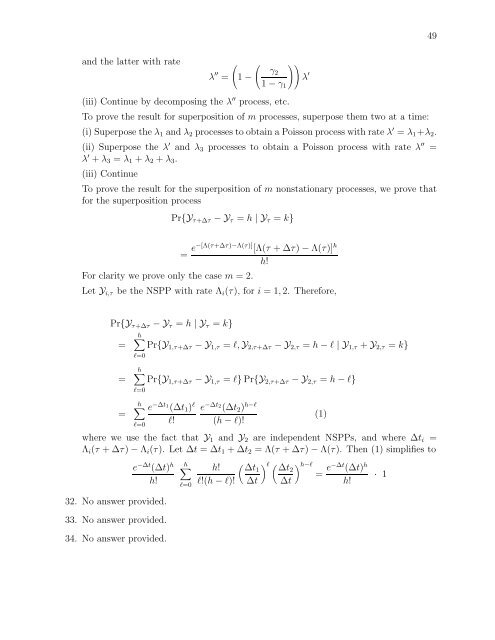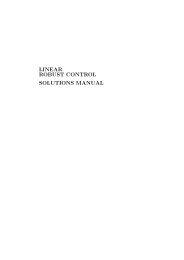SOLUTIONS MANUAL for Stochastic Modeling: Analysis and ...
SOLUTIONS MANUAL for Stochastic Modeling: Analysis and ...
SOLUTIONS MANUAL for Stochastic Modeling: Analysis and ...
You also want an ePaper? Increase the reach of your titles
YUMPU automatically turns print PDFs into web optimized ePapers that Google loves.
<strong>and</strong> the latter with rate<br />
(<br />
λ ′′ = 1 −<br />
(<br />
γ2<br />
1 − γ 1<br />
))<br />
λ ′<br />
(iii) Continue by decomposing the λ ′′ process, etc.<br />
To prove the result <strong>for</strong> superposition of m processes, superpose them two at a time:<br />
(i) Superpose the λ 1 <strong>and</strong> λ 2 processes to obtain a Poisson process with rate λ ′ = λ 1 +λ 2 .<br />
(ii) Superpose the λ ′ <strong>and</strong> λ 3 processes to obtain a Poisson process with rate λ ′′ =<br />
λ ′ + λ 3 = λ 1 + λ 2 + λ 3 .<br />
(iii) Continue<br />
To prove the result <strong>for</strong> the superposition of m nonstationary processes, we prove that<br />
<strong>for</strong> the superposition process<br />
Pr{Y τ+∆τ −Y τ = h |Y τ = k}<br />
49<br />
= e−[Λ(τ+∆τ)−Λ(τ)] [Λ(τ +∆τ) − Λ(τ)] h<br />
h!<br />
For clarity we prove only the case m =2.<br />
Let Y i,τ be the NSPP with rate Λ i (τ), <strong>for</strong> i =1, 2. There<strong>for</strong>e,<br />
Pr{Y τ+∆τ −Y τ = h |Y τ = k}<br />
h∑<br />
= Pr{Y 1,τ+∆τ −Y 1,τ = l, Y 2,τ+∆τ −Y 2,τ = h − l |Y 1,τ + Y 2,τ = k}<br />
l=0<br />
=<br />
h∑<br />
Pr{Y 1,τ+∆τ −Y 1,τ = l} Pr{Y 2,τ+∆τ −Y 2,τ = h − l}<br />
l=0<br />
h∑ e −∆t 1<br />
(∆t 1 ) l e −∆t 2<br />
(∆t 2 ) h−l<br />
=<br />
(1)<br />
l! (h − l)!<br />
l=0<br />
whereweusethefactthatY 1 <strong>and</strong> Y 2 are independent NSPPs, <strong>and</strong> where ∆t i =<br />
Λ i (τ +∆τ) − Λ i (τ). Let ∆t =∆t 1 +∆t 2 =Λ(τ +∆τ) − Λ(τ). Then (1) simplifies to<br />
e −∆t (∆t) h<br />
h!<br />
32. No answer provided.<br />
33. No answer provided.<br />
34. No answer provided.<br />
h∑<br />
l=0<br />
h!<br />
l!(h − l)!<br />
( ∆t1<br />
∆t<br />
) l ( ) h−l ∆t2<br />
= e−∆t (∆t) h<br />
∆t<br />
h!<br />
· 1















